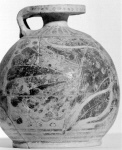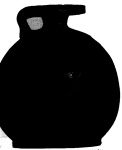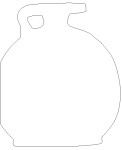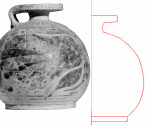
|
|
 |
|
There have been several articles in the CSA Newsletter about drawing pottery profiles with the aid of computers (most recently "A New Aid for Drawing Pottery Profiles,"). We have focused on ways to make the process faster and easier and on making the results more useful. It has been my contention in previous articles that profiles should be stored in CAD form (for the sake of improved data storage: real-world dimensions are stored in and may be retrieved from a CAD model; and for eventual output: drawings can be produced easily at any scale); so the articles have centered on finding better and easier ways to produce profile drawings in AutoCAD. I have written about tracing and using the NURBS curve to produce the best drawings, and Alexis Menten ("Computerizing Pottery Profiles - Yet Again,") wrote about the use of the program Draftsmantm to automate part of the process.
A new way of drawing profiles has recently been found, and it has much to recommend it. It occurred to me while I was on an AIA lecture tour; Professor Nancy de Grummond at Florida State University showed me a new, very high-tech system for making models of small archaeological objects. As we talked about the components of the system, one of which is a digital camera, it occurred to me that we could use a digital camera to provide the starting point for drawing pottery profiles. An image of a pot, taken with a telephoto lens to give as nearly a true profile as possible, could be imported into AutoCAD for tracing. The advantage is obvious - no need for a hand drawing as a starting point, hence a much speedier process.
The initial idea was that a digital photo could be imported into AutoCAD and traced. I realized, though, that there were more ways to improve and speed the process; so I began yet another experiment in making pottery profiles better and easier to create.
The first part of the process is quite simple. I could start with a digital photo of an object or a digitized version of an existing photograph. There is no particular reason to prefer one of these starting points over the other; the process is the same, regardless of the starting point.(1) I chose to scan a photograph for use in this test, since CSA has no digital camera.
I then imported the scanned digital image into PhotoShop® (I assume other programs could do the work PhotoShop does, but it was the program I used). I then let PhotoShop find the outline of the vase, which it will do by finding the outline of an area of a specific color. (I had first to reduce the color palette and fill in the light areas of the photo so that the program would see all parts of the pot as having the same tone; see Figs. 1-3 for the stages of this process, from original image to nearly-black-and-white image, to outline.) I saved the outline as a bitmap - black-and-white, no color and no grays - and imported the bitmap into AutoCAD.
 |
 |
 |
| Fig. 1 - The pot used in the experiment - scanned from a negative | Fig. 2 - The image after the first ajustments with PhotoShop | Fig. 3 - The outline after final PhotoShop adjustments |
At that point I needed only to trace the line and to scale the drawing. Tracing (using AutoCAD's spline command, which produces a continuous curve that passes through all the specified points) has been described before, and it is a relatively simple process. Zooming in on the drawing makes it possible to be extremely precise.
Scaling required only that I measure the height of the pot and scale the drawing accordingly.
The entire process of importing the drawing into AutoCAD, tracing the drawing, and scaling it took less than twenty minutes and resulted in a profile that matches the photograph very closely. Fig. 4 shows the profile as well as the profile superimposed on an image of the pot itself.
 Fig. 4 - The pot used in the experiment with
superimposed profile from AutoCAD drawing next to the right edge of the pot and the full profile
further to the right (enlarged and rotated so that the bottom and top are horizontal.
Fig. 4 - The pot used in the experiment with
superimposed profile from AutoCAD drawing next to the right edge of the pot and the full profile
further to the right (enlarged and rotated so that the bottom and top are horizontal.This process is not much different from the one used to create our standard profile in the last CSA experiment. In this instance, however, the process allows us to by-pass the original pencil drawing of the profile, since we can operate from a photograph, either digital or not. In fact, the more automated process described by Ms. Menten in her article could also commence with the digital photograph.
I used this process on a whole pot. While it would work on sherds, the gain in efficiency is not certain. Simple sherds are easy enough to draw that the added automation may not be significant. On the other hand, photographing many sherds at once, all positioned appropriately, might provide a very efficient starting point for drawings.
Time required for this work has been noted in past experiments, since the point of the work, in part, is to make the drawing process faster and more efficient. In this case, the AutoCAD work took about 16 minutes, and the PhotoShop work took about 7 minutes. I would expect both o be somewhat faster after practice. Scanning the photograph took only a few minutes. The total time spent was well under 30 minutes; however, the profile is not complete. There is no interior shown, because this method will not automate drawing the interior. The artist would be required to draw the interior as if working on paper but using AutoCAD instead - with some measurements and a good eye. This means that the time required is not certain, and, more important, that the drawing of profiles with this method must be done with the pottery at hand. Measurements to determine the interior shape will be required. Nonetheless, the paper drawing is eliminated as a starting point, and that would seem to make this a method to be considered with interest by anyone who must deal with a large quantity of pottery.
-- H. Eiteljorg, II
To send comments or questions to the author, please see our email contacts page.
For other Newsletter articles concerning pottery profiles and capacity calculations, consult the Subject index.
Next Article: Remembering Old Data
Table of Contents for the Spring, 1998 issue of the CSA Newsletter (Vol. XI, no. 1)
 Table of Contents for all CSA Newsletter issues on the Web
Table of Contents for all CSA Newsletter issues on the Web
(1) The digital photo may yield a lower-resolution image, but the difference in image resolution will not affect the outcome. A scanned image from a publication would also provide a suitable starting point. Return to text.